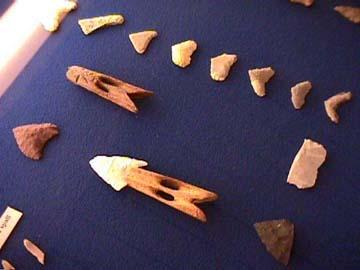
|
|
27 August, 2000
Even though it is Sunday, there are no church bells just the occasional
drone of the dogs. The minister is not here this week and so there will be
no service. We decided to go for a walk along the beach and found rocks
with raw garnets in them. The crystals were very small, but it was like
finding treasure anyway.
Wendy talked about her work with Musk Ox in Greenland, Alaska, and Norway.
She has gotten funding fromj different sources, including the Queen Mother
of Denmark, to create a cottage industry around the collection, spinning,
and knitting of Musk Ox hair. Its value is $150 a pound. In Greenland it
is gathered by hand in the field during the spring near Kangerlussuaq. In
Alaska and Norway there are some Musk Ox farms where the hair is harvested.
The hair used is the inner under hairs, not the courser outer guard hairs.
Wendy had a beautiful scarf she had knit herself; she seems to be
continually experimenting with different intricate patterns. The scarf was
incredably warm, like like holding a live animal.
We also told me about the existence of a large polynya in the Baffin Bay
area bordering the coastal area near Qaanaq. Polynyas are areas of open
seawater surrounded by ice caused by warm upwelling sea current. It
dramatically affects the ecosytem in this area providing nutrients for the
ice algae which in turn attract plankton, which provide food for
crustaceans, squid, fish, and the mammals that feed off of them. Man, of
course, being part of this ecosystem, as well as the birds that in turn
fertilize the shoreline giving rise to nutrients for the terrestial
ecosystem. This parcticular polynya has enabled life to flourish in this
harsh environment.
In the afternoon we went to the Museum whose caretaker is Torben Tiklev, who
also tranlates in the village between English, Danish, and Northern
Greenlandic. He translated our permit when it came before the fishing and
hunting community in Qaanaq. The museum is housed in the Rasmussen's
trading post which was first built at Thule in 1910 and later moved to
Qaanaq. There were four early cultures in this area: preDorset, Dorset I,
Dorset II, and Thule. Since these people were hunters they didn't live at
specific sites, but rather migrated to where the hunting was good and the
artifacts from the four cultures are found at the same sites.
We began a long discussion with some other tourists that were there, German
and Danish, about the origins of the kayak. Apparently skin covered boats
have been found near Lake Baikal in Russia and in northern Japan, besides
among the Inuit. It is believed that the Canadian Inuit introduced the
kayak to the Greenlandic Inuit. There is some debate on how the wood for
the keel was gathered. There is very little drift wood in this area.
Recently in Washington Land, 80 degrees north latitude, a landslide revealed
a wealth of timber under the snow. This area was a source for flint and
also still is a polar bear hunting area for the Inuit. Possibly this place
was the source for wood for the kayak.
Our evenings were again spent dissecting out the otoliths and cataloging
them for work up at the University of Hawaii upon our return.

The Qanaq museum.

Spear heads.

Combs and ear rings.

This is one of the meteorites found in this area. The largest one weighing 33.1 tons was taken by Peary and is now housed in the Natural History Museum in New York City. It was used as a source of metal for tools by the Inuit who later when asked seemed to forget where the other meteorites were located.

Toys carved from whale bone.

Contact the TEA in the field at
.
If you cannot connect through your browser, copy the
TEA's e-mail address in the "To:" line of
your favorite e-mail package.
|
